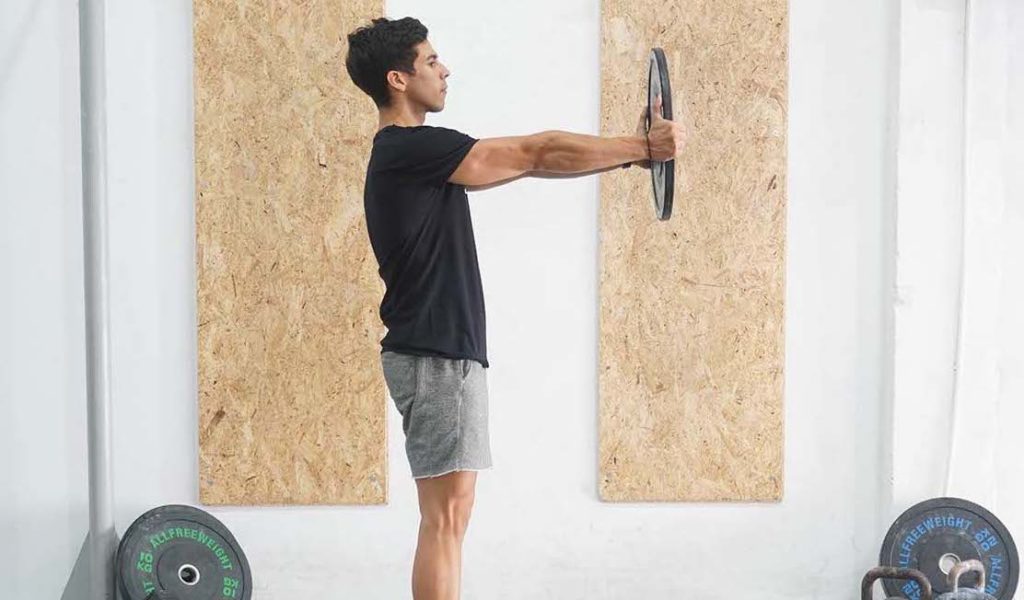Mastering the Dumbbell Arnold Press
Named after Arnold Schwarzenegger, the Arnold press is a fantastic dumbbell exercise that overloads and develops your shoulders, triceps, and upper chest. But, unlike the regular overhead press, the Arnold variation causes an intense burning sensation in your deltoids.
The Arnold press is beneficial because it develops your pressing strength while improving shoulder stability, leading to more balance, athleticism, and a lower risk of injuries. Instead of simply pressing the weights in a vertical line, you have to rotate your shoulders as you do. Doing so makes the movement much more difficult and improves muscle activation.
We recommend including the Arnold press early in your training, preferably first or second. The movement is highly technical, and you should perform it while you’re still fresh. Start with lighter dumbbells and focus on proper execution.
Level of Exercise: Intermediate
How to do a Dumbbell Arnold Press
- Set the back support of an adjustable bench in an upright position, grab a pair of light dumbbells, and sit down.
- Lift the dumbbells and rest them on your thighs.
- Bring your shoulders back, engage your abs, and take a breath.
- In one motion, thrust the dumbbells as you kick them with your thighs, bringing them to your sides.
- Take a breath and press the dumbbells to an overhead position.
- Lower the dumbbells slowly as you gradually rotate your wrists in. You should end up with the dumbbells in front of your neck and chin with palms facing your body. Exhale near the bottom.
- Take another breath and press the dumbbells, rotating your wrists out to complete the repetition with your palms facing forward.
What muscles does the dumbbell Arnold press activate?
The primary muscle group that works during the Arnold press is the deltoids, which engage to help us press the weight and maintain shoulder stability (1).
Our triceps also play an essential role in the Arnold press. The muscle group covers the posterior of the upper arms and produces elbow extension, which occurs as we press the dumbbells up (2). Similarly, the upper chest (clavicular head) assists the shoulders and triceps.
The upper back and midsection musculature promote a stable shoulder position and torso rigidity, allowing us to perform the movement seated or while standing.
Tips on the Dumbbell Arnold Press
When rotating the dumbbells, avoid supinating your wrists too much. Instead, turn your wrists until your palms face your torso diagonally. Doing so is beneficial for keeping tension on your deltoids and preventing your biceps from taking over.
Similarly, rotate your wrists smoothly, transitioning between wrist supination (palms facing you) and pronation (facing forward) as you press the dumbbells until your elbows extend entirely. That way, you’re better able to activate your medial deltoids and triceps.
Our third tip is to start with the movement in a seated position. Doing so is beneficial for getting used to proper technique without struggling to maintain your balance. Once you’re confident in your form, you can begin experimenting with the movement from a standing position.
Variations and Modifications of the Arnold Press with a Dumbbell
1. Dumbbell Overhead Press
The dumbbell overhead press is a more straightforward movement for beginners to strengthen and develop their chest, shoulders, and triceps (3). Unlike the Arnold press, an overhead press is about moving the weight up and down.
2. Single-Arm Arnold Press
Performing the Arnold press with one side at a time is a fantastic way to improve your technique, reduce the risk of muscle imbalances, and develop your core strength. Doing the movement with a single dumbbell makes it more challenging to balance, forcing you to pick the appropriate weight for your strength level.
Mistakes to Avoid
Using too Much Weight
As with most exercises, trainees often fall into the trap of loading as much weight as possible. Doing so prevents you from performing the movement correctly and rotating your wrists to transfer the tension between the shoulder heads. Avoid the error by starting with a lighter weight and gradually increasing the resistance while maintaining proper form.
Letting Your Elbows Drop
Trainees often make the mistake of allowing their elbows to drop to the stomach as they lower the dumbbells and rotate their wrists. Doing so takes the tension away from the deltoids and forces your biceps to work extra hard. Instead, keep your elbows in front of your chest in the low position.
Similar Exercises to the Dumbbell Arnold Press
Lateral Raise (Cable)
The lateral cable raise is a fantastic isolation exercise for the medial deltoids. Using cables provides constant tension, leading to better muscle activation, improved mind-muscle connection, and more growth.
Plate Front Raise

The plate front raise is an effective exercise that strengthens and develops the entire deltoid muscle group. Raising the weight in front of you forces significant activation in the midsection and front deltoids.

